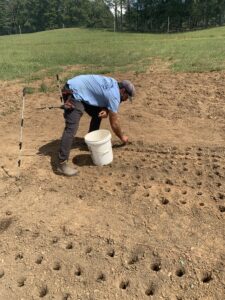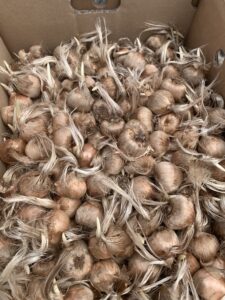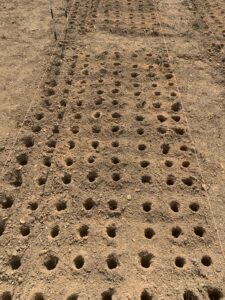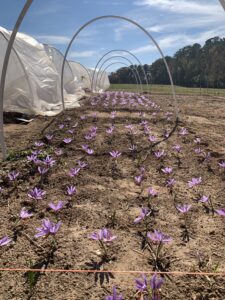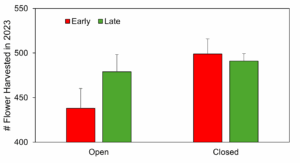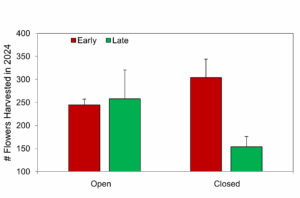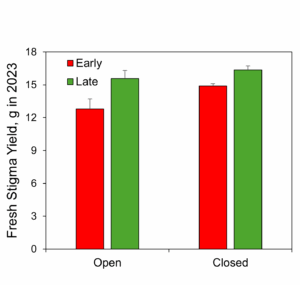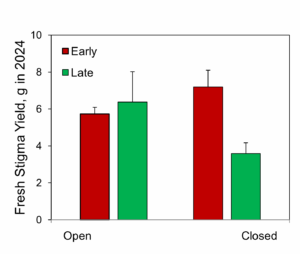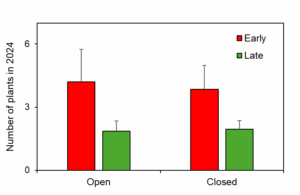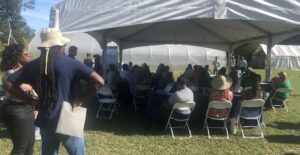Final report for OS23-166
Project Information
Crocus sativus L, commonly known as “saffron” is a perennial stem-less fall-blooming geophyte in the Iridaceae family. Renowned as "red gold," saffron stands as one of the most expensive spices by weight. Recent scientific interest in saffron has surged due to its potential therapeutic applications in combating cancer cells, Alzheimer's disease, and cardiovascular disorders. Similarly, the cultivation of saffron presents a promising avenue for smaller agricultural enterprises, offering opportunities for economic enhancement and sustainability through innovative production systems and diversified operations. However, saffron remains largely unexplored in the southern regions, particularly among underserved and small-scale producers. The primary objective of this project was to evaluate saffron as an alternative crop in Georgia by assessing its agronomic performance under different production systems and planting schedules at the Southeast Organic Center (SOC) during the 2023 and 2024 growing seasons. Saffron was cultivated under two conditions—open field and low plastic tunnel—with both early (September Planting) and late (October Planting) planting dates. In 2023, a total of 1,907 flowers were harvested, yielding 59.61 grams of fresh stigma. However, yields declined significantly in 2024, with only 961 flowers and 22.89 grams of stigma. This reduction could be attributed to the absence of compost application in the second year and a decrease in plant population due to the failure of some corms to sprout. Both production systems showed these declines: flower production in the open field dropped from 917 to 503 and in the low tunnel from 990 to 458, with corresponding stigma yields decreasing from 28.36 to 12.11 grams and 31.2 to 10.78 grams, respectively. Planting time also influenced performance; early planting in 2023 yielded 937 flowers (27.68 g), and late planting produced 970 flowers (31.92 g), whereas in 2024, early and late plantings yielded 549 (12.92 g) and 412 flowers (9.97 g), respectively. Despite the reduced yields in the second year, economic analysis indicated that saffron could generate a net revenue of $5,189 per 0.25-acre plot over two years. Profitability is expected to improve over time with better agronomic practices, such as soil fertility enhancement, compost use, irrigation management, and increased daughter corm production. In 2024 and 2025, we conducted three webinars, presented at three national and international conferences, and published a peer-reviewed article. The project was also featured at the SOC’s annual field day on 19th September 2024, attended by 73 participants. Ongoing laboratory analyses will evaluate saffron quality by quantifying key secondary metabolites—crocin (C₄₄H₆₄O₂₄), picrocrocin (C₁₆H₂₆O₇), and safranal (C₁₀H₁₄O)—across production systems and time. Overall, this study demonstrates that saffron has strong potential as a high-value alternative crop for small-scale growers in the southeastern U.S., particularly when supported by strategic agronomic practices.
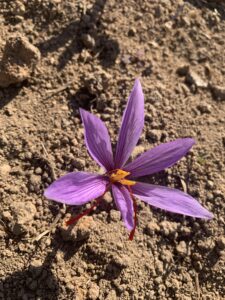
This project showcases a novel and sustainable method to produce high-quality saffron in the southern region. Our focus is on organic production, but the results will be useful for no-organic producers as well. Our objectives are to:
- Evaluate different production systems and planting dates for saffron production in southern states
- Evaluate the best method of processing saffron stigma for small-scale producers (using oven vs. microwave)
- Develop an enterprise budget to document the feasibility of saffron production in the region
Cooperators
- - Producer
- - Producer
Research
In this reporting period, we summarize the activities undertaken at the Rodale Institute Southeast Organic Center (33.5503, -84.7399), Chattahoochee Hills, Georgia, USA during 2023 and 2024. The climate is humid sub-tropical, with an average annual precipitation of 132.8 cm, and mean annual temperature of 16.16 oC. The soil is classified as sandy loam soil with a 6-10% average slope, 0.75% soil organic matter and near-surface bulk density of 1.55 g cm-3.
A research trial was established to evaluate saffron production in two systems including an open field and low-plastic tunnels. Both production systems were tested side by side and compared to each other. Within each production system, the study comprised of two planting dates, early planting (Sept 22) and late planting (October 17). The saffron corms were strategically planted at a depth of 6 inches, with each treatment meticulously replicated four times. Each plot was 8X4 ft in dimension.
During the blooming season in October, we conducted manual harvesting of saffron flowers, followed by the separation of stigmas from petals and stamens. Fresh yield data were recorded for each treatment. Subsequently, stigma samples underwent dehydration using a convection oven, with varying temperature and duration settings (100 °C for 10 minutes or 60 °C for 30 minutes). Additionally, a microwave oven was employed for a subset of samples under objective 2, employing a one-minute drying duration.
To determine the effect of the processing method on saffron quality, the concentration of crocin (C44H64O24), picrocrocin (C16H26O7), and safranal (C10H14O) which are the main apocarotenoids in stigmas will be measured through a quantitative nuclear magnetic resonance spectroscopy (qNMR) technique in 2025. For extracting the secondary metabolites of saffron, 100 mg of dehydrated saffron stigmas will be milled in a mortar. The ground saffron will be transferred to a TD-NMR glass tube, followed by adding a 1 ml DMSO-d6 solvent. The NMR spectra of the samples will be obtained in MNOVA, and the relative concentration of the secondary metabolites will be measured by performing the integration of target picks and compared among treatments.
Results from the field trial were used to develop an enterprise budget for saffron production in 2025. This financial framework analyzed the economic feasibility of saffron production in the region. By assessing costs, inputs, and potential returns, the enterprise budget serves as a compelling tool to demonstrate the viability and financial sustainability of introducing saffron into southern states' agriculture.
In 2023, our research plots produced a total of 1,907 saffron flowers, yielding 59.61 grams of fresh stigma. This included both open and low plastic systems with early and late plantings. However, in 2024, saffron yield declined significantly, with flower production dropping by nearly half to 961 flowers and total stigma weight decreasing to 22.89 grams.
In 2023, the total flower count was higher in the low plastic tunnel than in the open field when combining both early and late plantings. However, in 2024, the open field had a higher total flower count under the same conditions.
In 2023, late planting (October) resulted in more flowers in the open field, while early planting (September) produced a higher flower count in low plastic tunnels. Similarly, in 2024, late planting yielded more flowers in the open field, whereas in plastic tunnels, early planting had a noticeably higher flower count than late planting. When considering only the open and low plastic systems, without factoring in planting timing, a similar downward trend was observed. In the open system, flower production fell from 917 in 2023 to 503 in 2024, with stigma weight dropping from 28.36 grams to 12.11 grams. Likewise, in the low plastic system, flower count declined from 990 in 2023 to 458 in 2024, while stigma yield dropped from 31.2 grams to 10.78 grams.
Examining the impact of planting timing, without distinguishing between open and low plastic systems, early planting in 2023 resulted in 937 flowers and 27.68 grams of stigma, while late planting produced 970 flowers and 31.92 grams of stigma. In 2024, both planting times saw a marked decrease, with early planting yielding 549 flowers and 12.92 grams of stigma, and late planting producing 412 flowers and 9.97 grams of stigma.
In 2023, the total stigma yield was higher under low plastic tunnels when combining both early and late plantings. However, when analyzed separately, late planting in low plastic tunnels resulted in a higher stigma yield than early planting. Additionally, within both production systems, stigma yield was generally higher under late planting. This trend reversed in 2024, with open-field conditions producing a higher stigma yield than low plastic tunnels when combining both planting times. Furthermore, early planting yielded more stigma than late planting. When analyzed separately in 2024, stigma yield remained higher under late planting in open-field conditions, whereas early planting outperformed late planting in plastic tunnels.
These findings highlight a considerable reduction in saffron flower production and stigma yield in 2024 across all planting systems and timings, suggesting potential environmental and management factors affecting overall yield. The decline in yield may be partially attributed to the lack of compost application in the second year and a reduced plant population, as some corms failed to emerge. This resulted in fewer flowering plants in certain plots, potentially impacting overall saffron production.
Plants/corms number in second year
In 2023, we planted a single mother corm of saffron at each designated spot within our research plots, maintaining a spacing of six inches. To assess plant establishment, we conducted a random survey of saffron plants within each plot in the second year.
When analyzing planting date and system separately, we observed that early planting resulted in an average of four saffron plants, while late planting produced an average of two. Similarly, both open and low-plastic planting systems yielded an average of three plants.
When considering both planting date and production system together, we found that:
- Open system early planting resulted in an average of four plants.
- Open system late planting had an average of two plants.
- Low-plastic tunnel early planting also produced an average of four plants.
- Low-plastic tunnel late planting yielded an average of two plants.
These findings highlight the influence of planting time and production system on saffron establishment and corm production within the research plots.
Enterprise Budget
An enterprise budget was developed to evaluate the economic feasibility of saffron production in the region over a two-year period. Using the University of Vermont Enterprise Budgeting Guide, we estimated revenue for a 0.25-acre plot, analyzing costs, inputs, and potential returns to determine the financial sustainability of saffron farming.
Yield and Revenue Analysis
- Year 1: 28,272 flowers produced, with an average stigma weight of 0.0056 g/flower for 0.25 acres.
- Year 2: 14,288 flowers produced, maintaining the same average stigma weight for 0.25 acres. Note we recorded higher flower production in the first year compared to the second.
The market price for saffron was taken at $32 per gram, while corms were valued at $0.35 each. By the end of Year 2, the corm yield was estimated to be 60,800 corms per 0.25 acre.
Economic Summary (Per 0.25 Acre)
- Total saffron revenue (Years 1 + 2): $7627
- Total corm revenue (Years 1 + 2): $21,280
- Gross income (Years 1 + 2): $28,907
- Total cost (Years 1 + 2): $23, 718
- Total labor cost (Years 1 + 2): 9158
- Total net revenue over two years: $5,189
Profitability and Future Potential
Our analysis indicates that saffron farming can be a profitable venture, with a net revenue of $5K per 0.25 acres over two years. Profitability is expected to increase as the number of daughter corms rises, leading to greater flower production under optimized management practices. With improvements in soil fertility, irrigation, and pest control, long-term economic returns could be significantly higher.
Educational & Outreach Activities
Participation Summary:
The project team has incorporated an extensive education and extension plan into this project, including public field days and tours, webinars, fact sheets, and research articles. Since 1999, the Rodale Institute website (rodaleinstitute.org) has served as a leading source of information for farmers implementing or exploring regenerative and organic agricultural practices. The website receives an average of 47,000 visits and more than 94,000 page views per month and will be used for disseminating research results. The Rodale Institute social media accounts have more than 35,000 followers across multiple platforms and will be used along with the electronic newsletter, which has more than 15,000 subscribers who identify themselves as farmers or agricultural professionals, to publicize events and new reports or findings.
We sent a newsletter in December 2023 that featured the saffron project at Southeast Organic Center.
- The e-newsletter was sent on December 5 to 3,069 recipients. It received a 36% open rate, and a 2% click rate.
- Social Media Posts on Friday November 3rd on Saffron included:
Instagram:
- Reach- 3,450
- Engagement- 218
Linkedin:
- Impressions: 3,370
- Engagements: 99
Facebook:
- Reach: 1,915
- Engagement: 22
July 23rd, 2024 post on Saffron Update
Facebook: https://www.facebook.com/share/p/iKSkCsH65niedTHQ/
- Post Impressions: 1,300
- Post Reach: 1,284
- Engagements 35
Instagram: https://www.instagram.com/p/C9xyTIpgNSw/?utm_source=ig_web_copy_link
- Accounts Reached: 1,216
- Impressions: 1,318
- Accounts Engaged: 102
- Interactions: 106
Linkedin: https://www.linkedin.com/feed/update/urn:li:activity:7221605517201129475
- Impressions: 2,284
- Engagements: 254
- Engagement Rate: 11.12%
- Clicks: 197
- Reactions: 52
eNewsletter in 2024 featuring Saffron: The fourth e-newsletter of SOC was sent to >3000 subscribers on 19th December whereas the third e-newsletter was sent on 30th August. The second e-newsletter of SOC was sent on 30th June whereas the first newsletter was sent on March 28th. These newsletters showcased a variety of research projects, publications, and outreach activities at the SOC including saffron project.
Featured News Article
The Southern SARE-funded research on saffron production in Georgia was featured on WABE 90.1 FM, highlighting its potential as a high-value crop for farmers in the Southeast. The coverage showcases the work led by Rodale Institute’s Southeast Organic Center, emphasizing saffron’s adaptability to the region’s climate, its role in farm diversification, and its alignment with regenerative organic practices. This feature emphasizes the growing interest in saffron as a profitable and environmentally sustainable crop, offering farmers a resilient alternative in the face of economic and climatic challenges.
Listen to the radio segment: https://iqmediacorp.com/ExternalIframeMedia/?mediaID=2c5c23c1-eecd-41f5-bc69-d851f6f4c45d&isRM=false
Read the full article: https://www.wabe.org/researchers-test-growing-saffron-for-georgia-farms/
PRESENTATIONS
- Acharya, B.S., 2024. Saffron (Crocus sativus L.): The Golden Spice. RIFT Lecture, Rodale
- Acharya, B.S., Ghalehgolabbehbahani, A., 2024. Mysteries of Red Gold: Exploring Saffron Production in the Southern USA. ASA, SSSA, CSA International Annual Meeting. San Antonio, Texas, November 10-13, 2024. (Oral)
- Acharya, B.S., Ghalehgolabbehbahani, A., 2024. Saffron as an alternative high value crop for small-scale farms in the Southern USA. ASA Southern Branch Meeting. Atlanta, GA, USA, Feb 05, 2024. (Oral)
WEBINARS
- Acharya, B.S., Ghalehgolabbehbahani, A., 2025. The Golden Thread: Research Update. The 9th Annual Saffron Workshop. University of Vermont, USA, May 08, 2025.
- Acharya, B.S., Ghale, A. 28 August 2024: Saffron Cultivation in the US: Growing Conditions, Yield, and Quality. Rodale Institute Webinar. Webinar: Introduction to Saffron Cultivation in the United States—Growing Conditions, Yield, Quality (youtube.com) [There was a total of 205 people registered and 77 people watching it "live" during the broadcast]
- Institute, USA, 31st July 2024. Acharya, B.S., Ghalehgolabbehbahani, A., 2024. Saffron as an alternative high value crop for small-scale farms in the Southern USA. The 8th Annual Saffron Workshop: The Finer Points of Saffron Cultivation. University of Vermont, USA, April 04, 2024. https://www.youtube.com/watch?v=WFl6QRJZlXc
- A webinar on saffron is scheduled for June 4, 2025. Link: https://rodaleinstitute.org/events/webinar-exploring-saffron-production-in-the-southern-usa/
Our team submitted a review paper on saffron in August 2024, which has now been published in the "Journal of Agriculture and Food Research".
Acharya, B.S., Ghale, A., Hamido, S., Zinati, G., Bozzolo, A., Archer, L., Wendelberger, K., Das, S., Thapa, R. and Panday, D., 2025. Saffron (Crocus sativus L.): The Golden Spice—Management, Challenges, and Opportunities for Sustainable Production in the United States. Journal of Agriculture and Food Research, p.101970.
During the "Transition to Organic" Symposium SOC tour in October 2023, approximately 10 farmers visited our research site and were provided with in-depth information regarding our saffron research efforts.
2024 Annual Field Day
The Organic Field Day at the Southeast Organic Center on Thursday, September 19, provided a platform to showcase ongoing research on saffron production, among other crops in the Southeast. The event offered farmers and stakeholders valuable insights into the viability of saffron as a high-value crop. Participants engaged in discussions on saffron cultivation, its adaptability to the regional climate, and its potential for farm diversification within organic systems. The event facilitated networking and knowledge-sharing among researchers, educators, farmers, and policymakers, with a total of 73 attendees.
Media Coverage of the Saffron Project
Georgia Project Explores Saffron as Potential Crop – ATTRA – Sustainable Agriculture
https://www.wabe.org/researchers-test-growing-saffron-for-georgia-farms/
Georgia Trend Daily - Jan. 28, 2025 - Georgia Trend Magazine
The saffron project has garnered significant attention, highlighting its potential as a viable crop for Georgia. It has been featured in several news outlets, including WABE, which covered the research efforts and discussed both the challenges and opportunities of growing saffron in the region. ATTRA – Sustainable Agriculture also highlighted the WABE article including the project's goals and its impact on local farming systems. Additionally, Georgia Trend Magazine featured the project on January 28, 2025, further highlighting its significance and potential for Georgia’s agricultural landscape.
All outreach activities primarily targeted underserved minority farmers in the southern region. Encouragingly, we were contacted by several farmers expressing interest in growing saffron, motivated by its potential as a high-value alternative cash crop. This level of engagement reflects a growing awareness and enthusiasm around saffron cultivation among underserved communities. We are in contact with two farmers who will most likely grow saffron. Additionally, we are collaborating with universities and other agencies to develop grant proposals aimed at continuing and expanding research and outreach on saffron production.
Learning Outcomes
Project Outcomes
Considering the prevailing financial challenges encountered by small family farms, innovative avenues are crucial for supplemental revenues and diversification of farming practices. Particularly in Southern states, the increase in the frequency and intensity of climate-related catastrophes, notably hurricanes, underscores the need for resilient and economically viable agricultural choices. Importantly, saffron emerges as a promising solution, being a high-value crop that requires minimal additional equipment, seamlessly integrating into existing farm machinery such as small tractors, tillers, and discs.
In this context, the cultivation of saffron holds strategic significance, offering a pathway towards sustainable agriculture while addressing the financial challenges faced by small farms. The findings from our project enhances our understanding of saffron cultivation, paving the way for profitable ventures within the farming community. Importantly, saffron stands out as one of the most expensive spices globally when measured by weight, thus presenting a viable alternative income source for small-scale agricultural operations. Furthermore, the chemical composition of saffron, encompassing safranal, crocin, picrocrocin, as well as anthocyanins, flavonoids, vitamins, amino acids, proteins, starch, mineral matter, and gums, could have potential health and medicinal benefits. Studies have indicated its efficacy in treating various ailments ranging from cardiovascular diseases to stress, aging, skin conditions, sexual dysfunction, cancers, and cholesterol management. In 2025, we will be analyzing select chemical constituents present in saffron samples sourced from our plots, further enriching our understanding of their therapeutic potential.
Overall, our saffron project has demonstrated a unique economic opportunity for small farms, offering significant revenue potential without requiring substantial infrastructure investments. Beyond its profitability (see enterprise budget in result section), saffron cultivation enhances ecological services by improving pollinator activity, increasing biodiversity, and contributing to overall farm sustainability. Additionally, the striking saffron blooms add aesthetic value to the landscape, further enriching farm environments.
